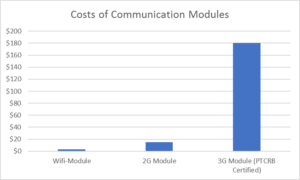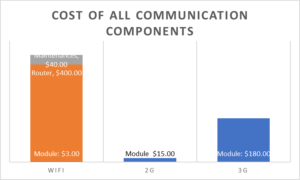Why We Stopped Using Wifi
AG Technology Consultant
When developing and designing ConnectedCrops, we looked very closely at Wi-Fi-based weather stations, and ultimately decided that it wasn’t a practical solution for most growers. In the long run, WiFi was both more expensive, when all costs are considered, and more difficult to maintain. This article provides a behind-the-scenes look into our product development process and why we came to this conclusion.
Several weather-sensing products on the market communicate over Wi-Fi. Our very first versions of the stations were also Wi-Fi-based. Initial results provided very good performance, battery utilization, and cost.
The benefits of a Wi-Fi-based system were: low power demand, and lower cost; Wi-Fi antennas are cheaper and less power-hungry than 3G cellular radios.
Costs:

Wi-Fi modules are 5% of the cost of a PTCRB certified 3G antenna.
So, why cellular?
Limited range:
We spoke with growers who told us about how important real-time data is to their operations. If you’re running a serious operation, you need field-specific data. The problem with a Wi-Fi station is that they had a limited range of 300 metres from an internet-connected Wi-Fi router, usually at the main farmhouse or barn. Using repeaters wasn’t very helpful because power lines were needed for the repeater. It was useful to test the sensors, however weather data near the main farmhouse wasn’t a big deal, usually you knew the weather near the main location, it was the remote areas that you didn’t want to bother to drive to and check. This was especially true for growers with multiple fields, some owned, some rented, and they needed better visibility at the remote locations.
Actual Costs:
The cost of the Wi-Fi module, although very small, required additional routers to be installed and configured. We found several outdoor Wi-Fi routers that could be installed and powered using an ethernet cable; depending on the amount of weatherproofing you get with the router, the cost escalated quickly. Best case, comparing all the costs, it looks like this:

Setting up and maintaining outdoor Wi-Fi requires technical know-how. To set up an outdoor router is challenging for most people, configuring IP addresses, firewall security, power-level settings to control range, and antenna positioning to improve range. We also learned that the router gets much less coverage in the summer when the foliage grows in. We achieved 800 metres of range in the winter, but only 300 metres of range in a vineyard/orchard when the canopy had grown in.
2G Cellular
The best choice appeared to be a weather station with a 2G module. It was the lowest cost and also provided the best flexibility in terms of range, power, and flexibility. 2G radios have a much less demanding power profile as compared to 3G radios. There are some cellular stations on the market that are less costly, many of these units are 2G units and they use common frequencies: CDMA 850/1900 and EVDO 850/1900.
The reason we didn’t go with 2G units is very simple: Cellular carriers are aggressively closing down their 2G network and expanding 3G, 4G LTE, and 5G support. This means that the stations on the market will stop working as soon as the nearby towers are shut down, which means you have to buy a new product. Depending on where you’re located, 2g will stop working:
| Sunset Date | ||
| Canada | ||
| Telus | January 31st 2017 | Reported |
| Bell | January 1st 2017 | Reported |
| Rogers | December 31st 2018 | Reported |
| USA | ||
| Verizon | Dec 21st 2019 | |
| AT&T | December 31st 2016 | Announcement |
The cellular carriers are all vague about when exactly 2G service will end. The sunset schedule depends on when towers will physically be serviced as well as other long-term contracts, etc. They will not authorize new devices to be deployed or serviced on 2G.
Conclusion
As a result of months of trials with growers, and ongoing conversations with carriers in Canada and the US, our results showed that Wi-Fi-based systems were very expensive and impractical for most growers, and 2G-based cellular units would stop working sometime in around 2017 if you’re in Canada and around 2019 if you’re in the US.
We found that, even at a more expensive module cost, 3G communications is the best solution for growers in the long term.